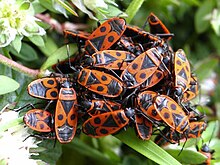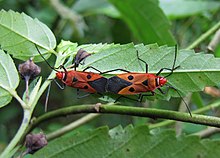
Pentatomidae is a family of insects belonging to the order Hemiptera, generally called shield bugs or stink bugs. Pentatomidae is the largest family in the superfamily Pentatomoidea, and contains around 900 genera and over 4700 species. As hemipterans, the pentatomids have piercing sucking mouthparts, and most are phytophagous, including several species which are severe pests on agricultural crops. However, some species, particularly in the subfamily Asopinae, are predatory and may be considered beneficial.
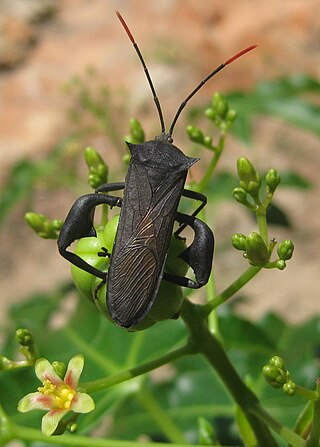
Coreidae is a large family of predominantly sap-sucking insects in the Hemipteran suborder Heteroptera. The name "Coreidae" derives from the genus Coreus, which derives from the Ancient Greek κόρις (kóris) meaning bedbug.

Pentatominae is a subfamily of Pentatomidae, a family of shield bugs. This subfamily is the largest one within the Pentatomidae, having 4937 species classified in 938 genera. Species in this subfamily are phytophages and several of them are considered agricultural pests. Some invasive pentatomines such as Halyomorpha halys and Bagrada hilaris have been considered household pests. Higher systematics of the group have been revised by Rider et al.

The Lygaeoidea are a sizeable superfamily of true bugs, containing seed bugs and allies, in the order Hemiptera. There are about 16 families and more than 4,600 described species in Lygaeoidea, found worldwide. Most feed on seeds or sap, but a few are predators.

Alydidae, commonly known as broad-headed bugs, is a family of true bugs very similar to the closely related Coreidae. There are at least 60 genera and 300 species altogether. Distributed in the temperate and warmer regions of the Earth, most are tropical and subtropical animals; for example Europe has a mere 10 species, and only 2 of these occur outside the Mediterranean region.

Coreinae is a subfamily in the hemipteran family Coreidae. They have been shown to be paraphyletic with respect to Meropachyinae.

The Harpactorinae are a large subfamily of the Reduviidae. About 300 genera and 2,000 species worldwide have been described. Some of the species of the genera Zelus, Pselliopus, Sinea, and Apiomerus are of interest as biological pest control agents.

Harpactorini is a tribe of the Harpactorinae. This group is the most diverse of the entire assassin bug family, with 51 genera recognized in the Neotropical Region and 289 genera and 2003 species overall.
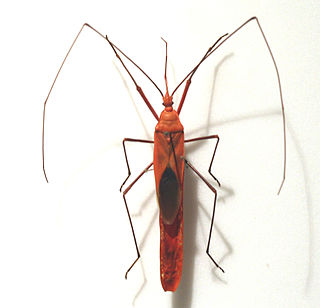
Macrocheraia is a genus of bugs in the family Largidae with a single species, Macrocheraia grandis found mainly in Southeast Asia but extending into parts of South Asia. This was referred to in some older literature under the genus Lohita, a name derived from the Sanskrit word for red.

Dysdercus is a widespread genus of true bugs in the family Pyrrhocoridae; a number of species attacking cotton bolls may be called "cotton stainers".
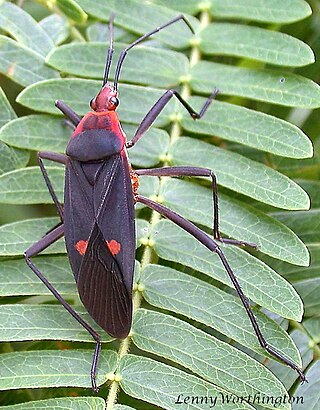
Melamphaus is an Old World genus of true bugs in the family Pyrrhocoridae, the cotton stainers. They are often confused with bugs in the family Lygaeidae, but can be distinguished by the lack of ocelli on the head.

Dysdercus cingulatus is a species of true bug in the family Pyrrhocoridae, commonly known as the red cotton stainer. It is a serious pest of cotton crops, the adults and older nymphs feeding on the emerging bolls and the cotton seeds as they mature, transmitting cotton-staining fungi as they do so.

Dysdercus suturellus is a species of true bug in the family Pyrrhocoridae, commonly known as a cotton stainer. The adult insect is slender, about 1 to 1.5 cm long, with a red thorax and dark brown wings marked with a yellow cross. It is native to the southeast of the United States, Jamaica and Puerto Rico. It is a pest of cotton crops and other plants, the adults and older nymphs feeding on the emerging bolls and the ripening seeds.

Dysdercus koenigii is a species of true bug in the family Pyrrhocoridae, commonly known as the red cotton stainer. It is a serious pest of cotton crops, the adults and older nymphs feeding on the emerging bolls and the cotton seeds as they mature, transmitting cotton staining fungi as they do so.
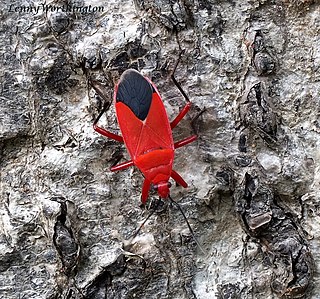
Antilochus coquebertii is an Old World species of true bug in the family Pyrrhocoridae, occurring in South and Southeast Asia. It is brightly coloured, red and black, and is a beneficial predator on other pyrrhocorids, especially the genus Dysdercus, which are crop pests. They are often confused with bugs in the family Lygaeidae, but can be distinguished by the lack of ocelli on the head, and they can be easily distinguished from Dysdercus by the lack of white stripes on the body. They are known to be cannibalistic in nature, but are not known to prey on human flesh or blood.

Cydninae is a subfamily of burrowing bugs in the family Cydnidae. There are about 11 genera and at least 40 described species in Cydninae.

Carpocorini is a tribe of stink bugs in the family Pentatomidae. There are more than 100 genera in Carpocorini.

Salyavatinae are a subfamily of the assassin bugs. They have a pan-tropical distribution with about 16 genera. They have two foretarsal segments and have a patch of fine hairs known as the fossula spongiosa on the fore and mid tibia. Many species tend to have spines on the head, pronotum, legs and abdomen. A few species have the foretibia flattened into leaf-like structures.

The Phyllocephalinae are a subfamily of shield bugs erected by Amyot and Serville in 1843.
